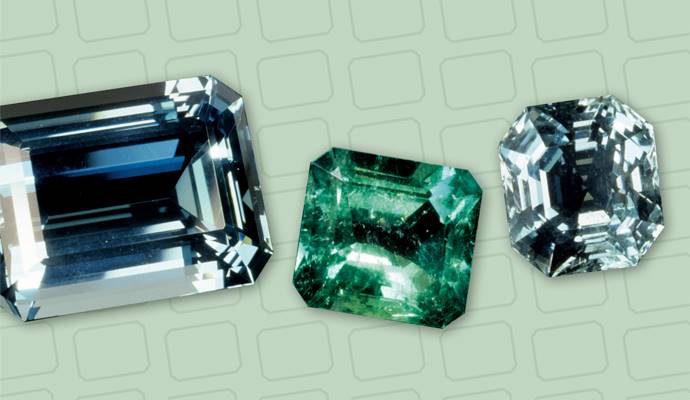|
Gemstones
Articles from GEMSTONES - LOOSE (254 Articles)

Emeralds and other Beryls
Coloured stone cuts: Emerald and other Beryls
By Katherine Kovacs
The shape of a gemstone variety's rough
will determine its best-possible cut. The emerald has had a cut so regularly
applied to it, that the cut itself was named "emerald cut". KATHERINE
KOVACS reports.
The emerald cut refers to a stone with a rectangular or square shape, with the corners cut-off to give it an octagonal shape, and thus differentiate the stone from a square princess or baguette cut.
The facets are fewer than many other cuts and are step-like, long and running parallel to each other rather than the smaller triangular facets found on a round brilliant cut, for instance. Cutting rules vary according to the rough stone but generally, an emerald cut will have two or three steps on the crown and about five on the pavilion.
The practice of “step” cutting dates back centuries but it isn’t just history or fashion that has made it so popular for emeralds – the emerald cut tends to produce optimal yield and colour from rough material. In most cases, the colour in a piece of rough emerald runs along the length of the crystal, but not terribly deep, rather like a rind on a lemon. (If one can imagine an elongated, rather than round lemon, of course.)
The great majority of emeralds have multiple inclusions and, as with other gems, a greater number of inclusions will detract from the gem’s value. The emerald, or step cut, may bring attention to these inclusions with its large table but, as with other coloured gems, colour and weight retention in the finished product are the primary consideration for cutters.
Some emeralds are so included that they are, rather affectionately, referred to as “jardin” (meaning garden) because of their resemblance to an overgrown garden of wild, mossy growth.
These jardin emeralds are cut to maximise colour because the inclusions scatter light so much that brilliance is limited.
In another variety of emerald from Columbia – trapiche – the cutting is done to maximise these unique inclusions. When oriented correctly, they form six neat, uniform spokes from a point in the middle of the gemstone.
Emeralds can be prone to breakage and chipping, especially with a large number of surface-reaching inclusions, and the squared-off corners of the emerald cut can provide some degree of protection. For the gem cutter, this is another reason why they may be more reluctant to cut rounds and ovals and why it is very difficult to source an emerald cut with sharp corners like a princess cut or an Asscher cut.
The tendency for emeralds to chip can cause some anxiety for the jeweller and setter, so it is good practise to explain the risk of chipping and/or breakage to a customer prior to a re-make.
Faced with an emerald that has many inclusions, or when in doubt, it may be worth seeking an experienced emerald setter even if it means paying a little more.
Sharing the same chemical composition as emerald are other members of the beryl family: aquamarine, yellow beryl (sometimes known as heliodor) and morganite. These gems tend to be less included than emeralds and are typically worth less by carat weight, which gives different considerations when cutting.
Cabochon-cut emeralds and other types of beryl are scarce in the Australian market, and higher quality material is usually used for faceting. Chatoyant or “cat’s eye” emerald and beryl do occur but are rare and the “eye” is often not very well developed.
Emeralds make beautiful earrings and pendants, but with their tendency to chip, some consideration must be taken by the customer if they choose an emerald for a ring. Care should be taken with all gem-set rings but a greater majority of jewellers counsel customers against using an emerald in an engagement ring because of its delicate nature.
Further, most emeralds are oiled – an acceptable and widespread treatment to mask inclusions – which means they should be kept out of ultrasonic cleaners and away from common household detergents like dishwashing liquid.
Aquamarines and other beryl don’t have the tendency to have as many inclusions as emeralds, but they are still considered to be a little too brittle for use in engagement rings or rings that are worn on a daily basis.
Posted April 01, 2010
|
|
|
|